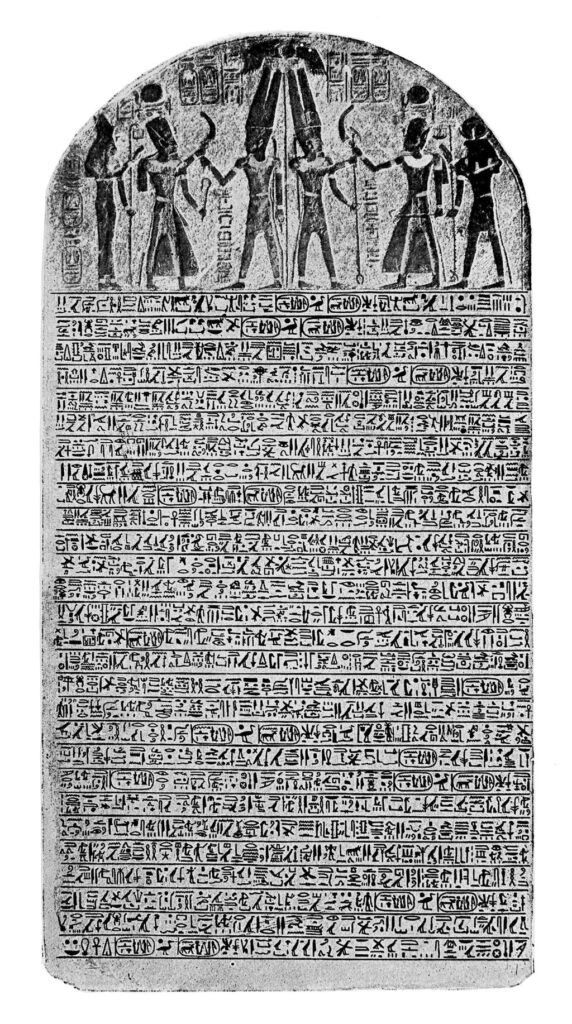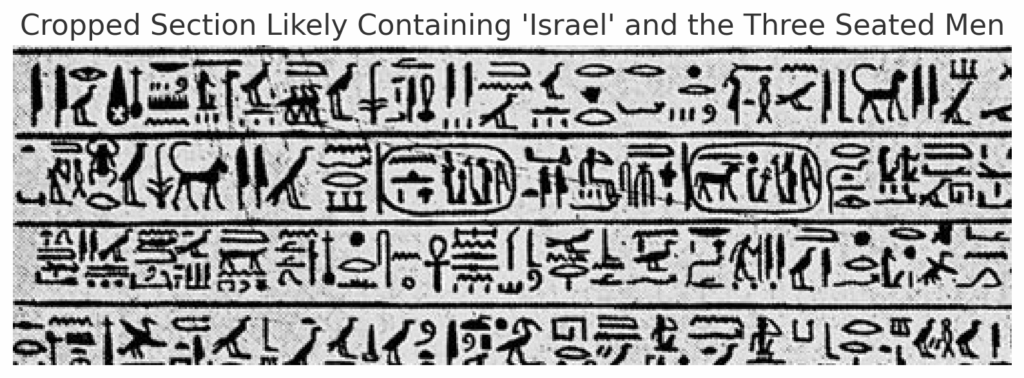A Clarifying Note on the Merneptah Stele and the Biblical Narrative
by Beezone

The Merneptah Stele, an Egyptian inscription dating to around 1208 BCE, contains the earliest known reference to a people called “Israel.” The inscription records that this group—identified as a people living in Canaan—was defeated by Pharaoh Merneptah during a military campaign. That is the extent of what the stele says. It makes no mention of Egypt as their previous home, nothing about slavery, no Exodus, and no reference to Abraham, Jacob, or Moses.

Despite this, some writers have tried to read much more into the inscription than it says. They attempt to link it to the biblical story of the Hebrews in Egypt—asserting that this reference to “Israel” confirms the Genesis narrative of Abraham entering Egypt or the Exodus under Moses. But these claims are unfounded.
For example, early 20th-century writer T. Tofteen attempted to link the Sebek-khu stela—another Egyptian inscription from the Middle Kingdom—to the biblical patriarch Jacob and his son Joseph, arguing that the name of Sebek-khu was Joseph himself. Egyptologist T. Eric Peet flatly rejected this interpretation, calling it “impossible” and showing that such readings relied on highly speculative connections rather than linguistic or historical evidence.¹
The determinative used in the Merneptah Stele—three seated men—simply indicates that the name refers to a group of people, not a city. The phonetic spelling, reconstructed by scholars as “ysrir” (Y-S-R-R), is widely accepted to refer to the people later known in biblical tradition as Israel.² But this does not imply continuity with the biblical patriarchs. There is no indication in the stele that this “Israel” had ever lived in Egypt or was descended from Abraham.
Leading scholars such as Israel Finkelstein and Neil Asher Silberman caution against importing biblical narratives into archaeological data.³ Egyptologist Donald B. Redford emphasizes that there is no Egyptian record of Israelites in Egypt and that attempts to find confirmation of biblical stories in such texts are retroactive projections.⁴ As Redford states, “the entire biblical account of the sojourn in Egypt and the Exodus has no historical foundation.”⁵
The Merneptah Stele offers a glimpse into Egyptian foreign campaigns and confirms that a people called “Israel” existed in Canaan in the late 13th century BCE. But linking that fact to the patriarchal stories or the Exodus is a leap not supported by the evidence. It is a case of reading modern religious expectation into ancient, unrelated records.
📚 References:
-
T. Eric Peet, The Stela of Sebek-khu: The Earliest Record of an Egyptian Campaign in Asia, (London: University Press of Liverpool, 1914), Preface, pp. v–vi.
-
K. A. Kitchen, On the Reliability of the Old Testament, (Grand Rapids: Eerdmans, 2003), p. 307. (Kitchen supports a conservative reading but affirms the phonetic identification of “Israel” as a people in Canaan.)
-
Israel Finkelstein & Neil Asher Silberman, The Bible Unearthed: Archaeology’s New Vision of Ancient Israel and the Origin of Its Sacred Texts, (New York: Free Press, 2001), esp. pp. 44–46.
-
Donald B. Redford, Egypt, Canaan, and Israel in Ancient Times, (Princeton: Princeton University Press, 1992), pp. 408–409.
-
Redford, ibid., p. 408.
Notes:
🔍 Is the “three seated men” determinative universally agreed to mean Israel, son of Abraham?
🪶 Short Answer:
No—the “three seated men” do not translate to “Israel,” and they certainly do not link the name to Abraham’s son in any explicit way. Here’s how it really works:
🧱 What the “three seated men” glyph means
✔️ Universally agreed among Egyptologists:
-
The three seated men determinative means “people”—a tribal or ethnic group.
-
It does not represent any letters or syllables.
-
It is a category marker, like a silent footnote saying: “This is a people, not a city or place.”
-
It doesn’t say “Israel.”
-
It says: “whatever this name is, it’s a people group.”
🪨 What the Tablet (Merneptah Stele) Shows—No More, No Less:
-
Date: Around 1208 BCE, during the reign of Pharaoh Merneptah.
-
Location of Mention: In the context of Merneptah’s campaign in Canaan (Palestine).
-
Textual Reference: A line that says something like:
“Israel is laid waste, its seed is no more.”
-
Determinative Glyph:
-
Egypt used a specific hieroglyphic symbol (three seated men) to mark “Israel” as a people, not a city or state.
-
Other names in the same inscription (Ashkelon, Gezer, Yanoam) are marked as settlements or city-states.
-
🧱 What about the name itself (“ysrir”)?
⚖️ Widely but not absolutely universally agreed:
-
The consonants Y–S–R–(I)–R are taken by most Egyptologists and Semiticists to correspond to “Israel” (Yisra’el) as it appears in Hebrew.
-
It is the best linguistic fit among Semitic tribal names known in that period.
🧠 What Does This Mean?
If “Israel” was present in Canaan during Merneptah’s reign—and Canaan was part of the Egyptian imperial sphere—then:
🔹 The Egyptians would have been aware of Israel as a regional people.
🔹 Contact doesn’t imply enslavement or residence in Egypt—Israel could have come to Egyptian attention in Canaan itself.
🔹 This reinforces the idea that biblical Israel may have emerged locally in Canaan, not from a historical Exodus out of Egypt.